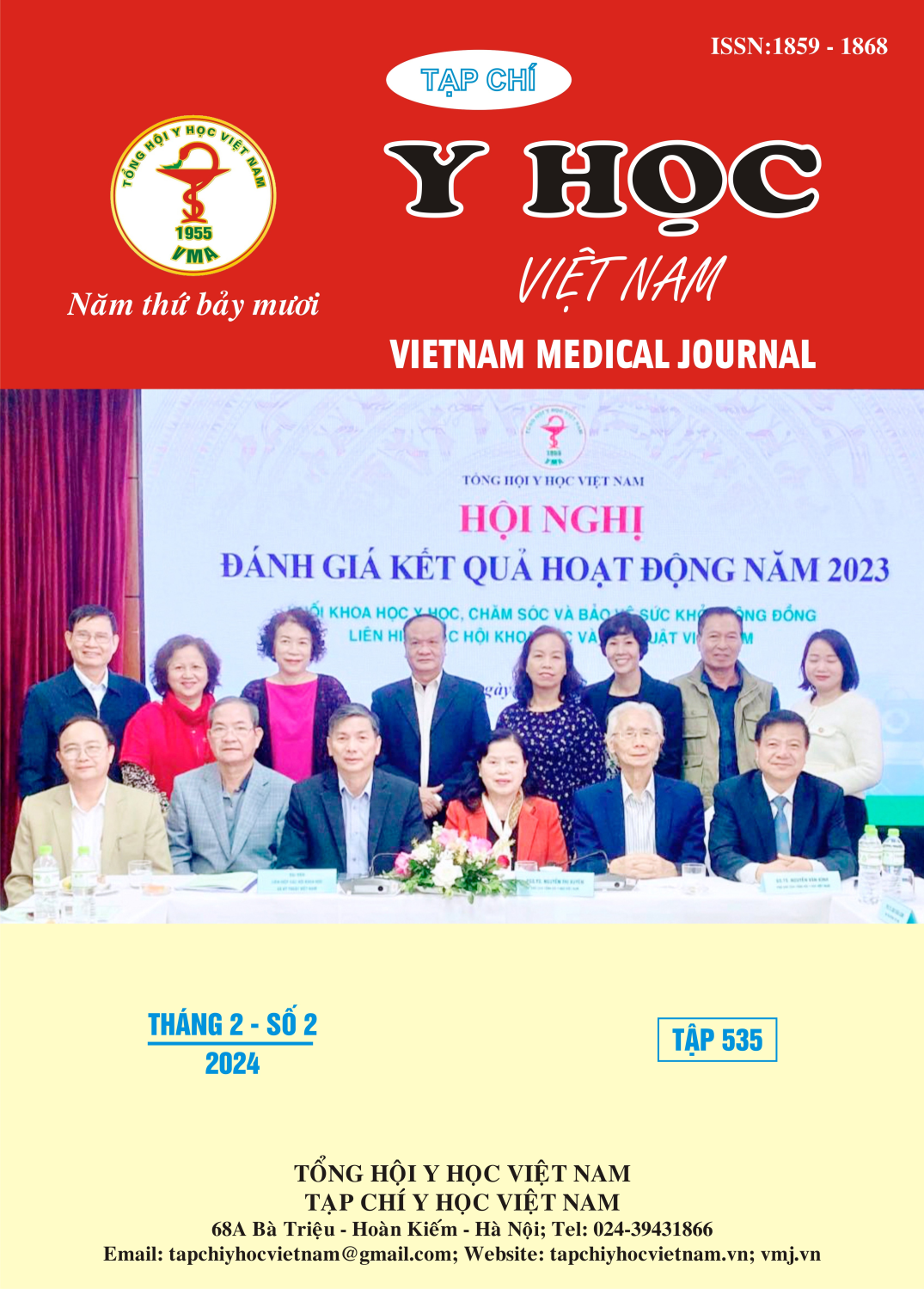EFFICACY AND LACTATE LEVELS AS A PROGNOSTIC PREDICTOR OF IN-HOSPITAL MORTALITY IN VENO-ARTERIAL EXTRACORPOREAL MEMBRANE OXYGENATION SUPPORT FOR ACUTE MYOCARDITIS
Main Article Content
Abstract
Background: Acute myocarditis is a medical condition characterized by heterogeneity in its clinical manifestation and disease severity. Approximately 12% of patients with acute myocarditis develop complications such as acute heart failure, arrhythmias, and dysfunction of the left ventricle. For individuals experiencing cardiogenic shock due to acute myocarditis, the utilization of veno-arterial extracorporeal membrane oxygenation (VA ECMO) emerges as a secure and efficacious treatment approach, with survival rates ranging from 61.2% to 71.9%. In Vietnam, the application of VA ECMO for the management of acute myocarditis-induced cardiogenic shock remains poorly documented in terms of treatment effectiveness and in-hospital mortality prognistic factors. Objective: To examine the in-hospital outcomes and prognostic factors related to cardiogenic shock due to acute myocarditis cases treated with VA ECMO at Cho Ray Hospital between 2019 and 2023. Patients and methods: A descriptive cross-sectional retrospective study. This study included 92 patients who diagnosed acute myocarditis and treated with extracorporeal membrane oxygenation at Cho Ray Hospital from January 2019 to March 2023. Results: This study analyzed 92 cases of acute myocarditis treated with VA ECMO at Cho Ray Hospital. The average age was 34.2 years, with males comprising 35.9% of the cases. The average heart rate and blood pressure at admission were 121.4 ± 35.9 beats per minute and 68 (50 - 73.3) mmHg, respectively. The pre-ECMO vasoactive-inotropic score (VIS) was 40.15 (21.05 -90.4). Cardiac arrest occurred before VA ECMO initiation in 9.8% of the cases, while VA ECMO was performed during ECPR in 4.3% of the cases. The hospital stay median was 16 days, ECMO duration was 6 days, and the mortality rate was 16.3%. Pre-VA ECMO, the median blood lactate concentration was 5 (3 - 8.9) mmol/L. Survivors had lower blood lactate levels compared to nonsurvivors (4.3 vs 10.4 mmol/L, p < 0.01). During the initial 72 hours post-VA ECMO initiation, blood lactate levels were associated with in-hospital mortality. After 48-72 hours of VA ECMO initiation, the consistent rise in blood lactate levels was found to be a predictor of in-hospital mortality, with AUC values of 0.78 and 0.8, respectively. Conclusion: The in-hospital mortality rate of acute myocarditis with VA ECMO support has decreased compared to previous studies. Pre-VA ECMO, elevated blood lactate levels are associated with increased in-hospital mortality. Blood lactate levels continue to rise after 48-72 hours of VA ECMO support and serve as a reliable predictor for in-hospital mortality.
Article Details
References
2. Hao T, Jiang Y, Wu C, et al. Clinical outcome and risk factors for acute fulminant myocarditis supported by venoarterial extracorporeal membrane oxygenation: An analysis of nationwide CSECLS database in China. Int J Cardiol. 2023;371:229-235. doi:10.1016/j.ijcard.2022.09.055
3. Nunez JI, Reyes-Castro T, kennedy kevin, et al. Abstract 13058: Outcomes With Venoarterial Extracorporeal Membrane Oxygenation for Acute Myocarditis: A 20-year Experience From the ELSO Registry. Circulation. 2021;144(Suppl_1):A13058-A13058. doi:10.1161/circ.144.suppl_1.13058
4. Ammirati E, Vandenbriele C, Nascimbene A. Key Predictors of Outcome in Patients With Fulminant Myocarditis Supported by Venoarterial Extracorporeal Membrane Oxygenation. Circ Heart Fail. 2023;16(7):e010670. doi:10.1161/ CIRCHEARTFAILURE.123.010670
5. Hajjar LA, Teboul JL. Mechanical Circulatory Support Devices for Cardiogenic Shock: State of the Art. Crit Care. 2019;23(1):76. doi:10.1186/s13054-019-2368-y
6. Scolari FL, Schneider D, Fogazzi DV, et al. Association between serum lactate levels and mortality in patients with cardiogenic shock receiving mechanical circulatory support: a multicenter retrospective cohort study. BMC Cardiovasc Disord. 2020;20(1):496. doi:10.1186/ s12872-020-01785-7
7. Hyun J, Kim A ram, Lee SE, et al. Vasoactive-Inotropic Score as a Determinant of Timely Initiation of Venoarterial Extracorporeal Membrane Oxygenation in Patients With Cardiogenic Shock. Circ J. 2022;86(4):687-694. doi:10.1253/circj.CJ-21-0614
8. Marbach JA, Di Santo P, Kapur NK, et al. Lactate Clearance as a Surrogate for Mortality in Cardiogenic Shock: Insights From the DOREMI Trial. J Am Heart Assoc. 2022;11(6):e023322. doi:10.1161/ JAHA.121.023322


